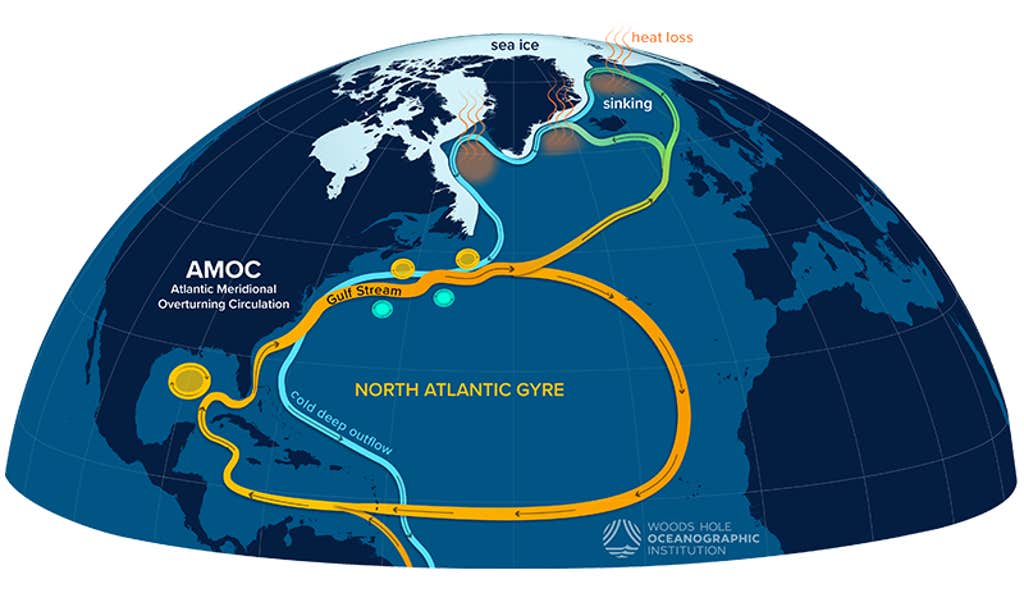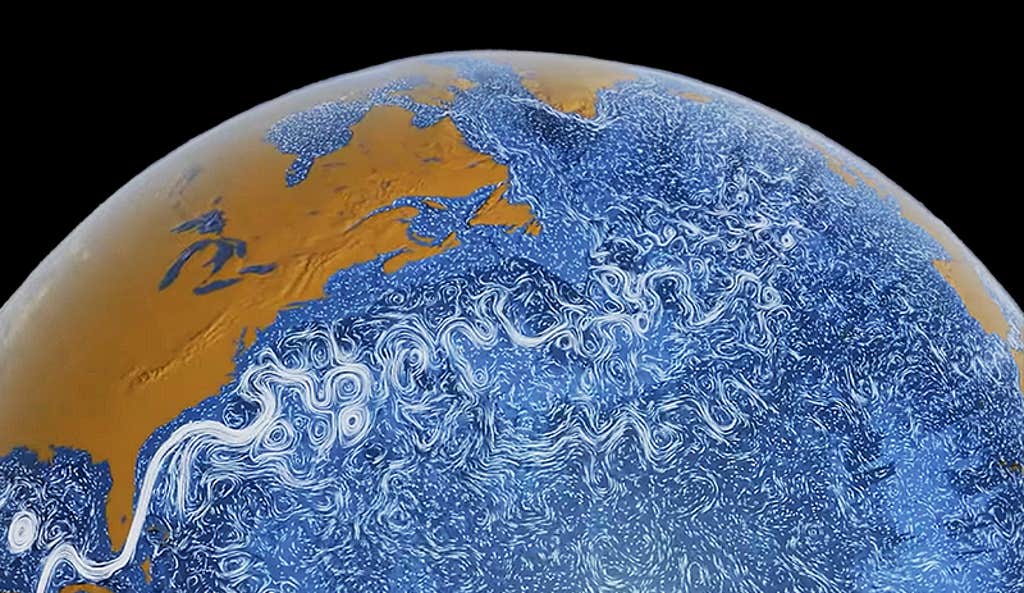From our small, terrestrial vantage points, we sometimes struggle to imagine the ocean’s impact on our lives. We often think of the ocean as a flat expanse of blue, with currents as orderly, if sinuous, lines. In reality, it is vaster and more chaotic than we can imagine. Its waters move in ways that lack a terrestrial equivalent and, in doing so, the ocean shirks tidy metaphor.
Right now, in the Atlantic Ocean alone, a single current, the Gulf Stream, is moving more water than all the world’s rivers combined. Across the ocean’s face, invisible to the naked eye, hundreds of eddies are whirling. Most of them are larger than the state of Rhode Island and reach more than three miles into the deep.
We are doing large-scale experiments to our global climate system.
The ocean’s power reaches far onto land. Its movements transport vast amounts of salt, nutrients, oxygen, CO2, and heat across the planet. In the absence of ocean currents, large portions of Earth would be uninhabitable due to buildups of extreme heat and cold around equatorial regions and poles, respectively. The ocean is the engine that powers so much of our climate and, by extension, the throttle and governor that regulates it. Above all, the ocean sets the stage upon which we conduct our lives.
Change a current and you can change how heat travels around the planet. You can change temperature, change rainfall, change everything that makes a place habitable to you and me. But in an era when humanity’s actions test and destabilize Earth’s delicate balances, many oceanographers believe that we are headed toward a great oceanic shift, one that could abruptly—and devastatingly—alter climate patterns worldwide.
You don’t have to travel back far in Earth’s history to find a moment when the ocean upended the global climate.
About 13,000 years ago, as the planet warmed and the ice sheets that covered it began retreating, a mysterious and abrupt cooling occurred. Most of the changes centered around the North Atlantic. A graph of climate conditions in Europe, Greenland, and eastern North America during this time shows the temperature line drop as if in a great swan dive. The decline did not take centuries or millennia; it took place over the course of a few decades. Newly thawed regions returned to a near-glacial climate. In some places glaciers grew, forests died back, and dry conditions set in on once-verdant land. Average temperatures around the North Atlantic dropped by about 9 degrees Fahrenheit. In Greenland, the temperature dropped by 18 degrees Fahrenheit—a change, as far as average temperatures go, like turning parts of New York state into central Alaska.

The effects of this event were not isolated to the North Atlantic. Paleo-climate records show a shift in monsoon patterns across the tropics, as well as altered climate patterns in China, South America, Africa, and the western United States. Some archaeologists even note a shift in human lifestyles, marking a return from settled to more nomadic living. More than a millennium would pass before temperatures abruptly returned to their previous highs.
This period of Earth’s history is called the Younger Dryas, named for a cold-hardy flower that flourished in Europe at the time. It is considered the last great cold period in the transition from the Ice Age to the current geologic epoch, the Holocene. While there is some debate around what caused this drastic climactic shift, many scientists believe the culprit was the collapse of the Atlantic Meridional Overturning Circulation (AMOC): a web of currents responsible for circulating warm water northward at the Atlantic Ocean’s surface and cold water southward in its depths. While the AMOC might sound esoteric, it is one of the most important systems in Earth’s climate.
In the ocean, water is far from uniform. Water in the tropics, due to evaporation and rainfall patterns, is saltier than water near the poles. As tropical water flows northward in the Atlantic, pushed by wind and pulled by differences in ocean density, it loses its heat in high latitudes. As a result, the water is no longer just salty, but cold and dense as well. So dense, in fact, that it begins to sink and penetrate the ocean’s deepest layers. Once there, the water begins a long journey south, joining a great, globe-spanning loop connecting every region of the ocean.
This loop is called the global thermohaline circulation—thermo meaning heat, haline meaning salt. The global thermohaline circulation is sometimes described as a conveyor belt, but the metaphor only extends so far in a system as fickle and shifting as the ocean. In time, the once-tropical water resurfaces, although this may be anywhere from 100 to 1,000 years later depending on the path it takes. In this simplified sense, we can imagine the AMOC as one part of a great complex of ocean currents responsible for shifting massive amounts of salt and heat around the planet.
Is a great oceanic shift upon us? Is a critical ocean system on the verge of collapse?
Along with events like the breakup of the Greenland and West Antarctic ice sheets, boreal forest dieback, and a permanent El Niño in the Pacific, an AMOC shutdown is considered a tipping point in Earth’s climate system. Tipping points are thresholds that, once crossed, rapidly alter the equilibrium of the planet. Scientists believe that during the Younger Dryas, the AMOC collapsed after massive amounts of freshwater from melting ice sheets flooded into the North Atlantic. The water there became too fresh and light to sink. The result severed—or at the very least, severely weakened—the connection between the AMOC’s upper and lower flows, altering the global thermohaline circulation at large. The very nature of how heat moved around the planet had changed.
As Earth warms and melting freshwater from the Greenland Ice Sheet cascades into the North Atlantic, many scientists fear that the stage is now set for a repeat of the Younger Dryas. By some estimates, the AMOC has slowed by 10 to 15 percent in the past century, leading to concern that the system could be headed for a collapse.
“A substantial weakening or shutdown of AMOC would be catastrophic,” says Jerry McManus, an Earth scientist at Columbia University who studies past changes in climate and ocean circulation. Computational models suggest that Europe could plunge into temperatures not felt since the last Ice Age, while parts of the southern hemisphere would bake. The eastern seaboard of the United States would see a rapid increase in sea level rise, while the monsoon rains, on whose regularity so much of the world relies, would slip south. Mass migration would take place. Agricultural systems would collapse. War and political upheaval would likely follow as people scrambled to adapt. The very fabric of life would be changed across much of the planet. “Our society is struggling with a degree or two of change,” says McManus. “We couldn’t possibly cope with 4 degrees in, say, a decade.”
In the summer of 2023, siblings Peter and Susanne Ditlevsen of the University of Copenhagen published a study warning of impending AMOC collapse. Using records of sea surface temperatures collected since the 1870s, they developed a new statistical approach to modeling the AMOC’s strength over time. Their model predicted a likely collapse around the year 2057, with a 95 percent chance of this happening before 2095 and a slight chance that it could arrive by 2025. By contrast, the Intergovernmental Panel on Climate Change (IPCC) had previously said the AMOC would slow during this century but not likely collapse before 2100.
The findings were published in the journal Nature Communications and set off a media frenzy. “Gulf Stream could collapse as early as 2025, study suggests,” read one headline that conflated the AMOC with the better-known Gulf Stream. (This happens often; the Gulf Stream, a wind-driven current that runs along the western edge of the mid-Atlantic before arcing toward Europe, is part of the AMOC. The Gulf Stream’s future circulation is indeed a matter of concern, but it occupies just one stage on the AMOC’s grand theater.) “Is a Mega Ocean Current about to Shut Down?” read another. “Scientists detect sign that a crucial ocean current is near collapse.”
Many oceanographers pushed back against the study’s claims. Some questioned how much could be gleaned from sea surface temperatures when so much of the AMOC’s behavior is dictated by salinity and temperature at depth. One model, others noted, is hardly representative of scientific consensus. While scientists generally agreed that the AMOC could stop as a consequence of global warming, predicting if and when this would happen was very difficult.

“There’s no tipping element on Earth for which we can predict a tipping time at this point,” says Niklas Boers, an Earth scientist at the Technical University of Munich who specializes in modeling climate tipping points. “To predict down to an exact time of collapse is nearly impossible.”
The barriers to predictability, Boers explains, involve the nuances of modeling and the data that underlie it. Some models, like the one used by the Ditlevsens, use proxies like sea surface temperatures to represent the entire system as a whole. Among their limitations is uncertainty in long-term historical data. For example, even though temperature and salinity records go back to the late 19th and early 20th centuries, early collection methods were unrefined and sparse by today’s standards.
Other models are physics-based: They attempt to digitally recreate the complexity of oceanic and atmospheric physics. Among their limitations is computer power. “Even on the best supercomputers, our most advanced climate models can take six months to a year to run,” says Boers. To work around these constraints—and also the ocean’s staggering complexity—models can be run at lower resolutions or be simplified. These models provide critical insights into ocean dynamics but are far from being a true “digital twin” of the ocean.
Leading climate models, like the ones underlying the IPCC reports, do suggest that the AMOC will slow, but few have foretold a complete collapse except under extreme climate scenarios.
On this planet, things can get weird fast.
Recently, however, a study led by oceanographer René van Westen of Utrecht University grabbed headlines after its model found that even a gradual freshwater increase in the North Atlantic—as might be expected from melting glaciers and the Greenland ice sheet—would eventually lead to a sudden AMOC shutdown. (They also modeled the global climate consequences, which included temperatures falling by more than 10 degrees Fahrenheit across much of Europe and a flip-flopping of the Amazon’s rainy and dry seasons, which would push that system toward its own tipping point.) The researchers concluded that an AMOC collapse could no longer be considered theoretical under current climate conditions and that “the present-day AMOC is on route to tipping.” Still, they noted that it remains impossible to know precisely how near or far that threshold is.
Despite the robust evidence from climate models, an AMOC slowdown has not yet been confirmed through direct observations. Only since 2004 have scientists used ocean-spanning sensor arrays to continuously measure the system; these provide insight into its dynamics, but it’s too soon to know whether the slowdown they’ve detected is part of AMOC’s natural variability versus a long-term trend.
Oceans are non-linear and chaotic systems. Nothing scales in a straight line, and small perturbations can cause large changes. To understand the mechanisms of and threshold for an AMOC tipping point is to understand a great Gordian knot of factors: CO2, freshwater forcing, relative density, vertical mixing, net evaporation, wind patterns, pressure gradients, bathymetry, atmospheric forcing, Greenland Ice Sheet stability—a list that can go on and on. Each force pulls on the others, making the threshold for AMOC’s collapse blurry and ever-shifting. Better models and richer datasets may someday provide more clarity, but for now the future can only be seen in low resolution. There have been false alarms: In the early 2000s, researchers observed a sharp slowdown in the AMOC that was not predicted by scientific models. Some scientists feared that an AMOC tipping point was imminent. The circulation rebounded.
In the aftermath of the Ditlevsen and van Westen studies, scientists who were asked to respond faced a conundrum: How should they convey uncertainty without downplaying severity? Could they leave room for nuance without making space for climate deniers? Or should they ring the figurative alarm and shout “FIRE!” even if the probabilities might only be small and distant?
“Uncertainty is a very tough topic in this field to convey,” says Nick Foukal, a physical oceanographer at Woods Hole Oceanographic Institution. If a researcher expresses certainty about something that doesn’t come true, “you’re held up as an example of not telling the truth. But if you say that something’s not likely, people just ignore you.” Yet when the stakes of an AMOC collapse are so high, it’s hard not to ring the alarms. Existential risk changes the communications calculus. A 5 percent chance of a paper cut warrants a very different response than a 5 percent chance of a climate upheaval and ecological collapse.
It might not be as bad as some fear. It may be worse than we can imagine.
Even so, Foukal cautioned, many “unknown unknowns” remain to be discovered about the AMOC. While in the past it appears to have alternated between strong and weak modes, the system may also have intermediary states. As sea ice melts, key overturning locations could migrate to saltier or colder regions of the ocean where water still becomes dense enough to sink. Perhaps those patterns change some ocean dynamics—but not devastatingly so. “There’s good evidence to show that AMOC may be more resilient than we think,” Foukal says.
Yet even if the AMOC’s future is more nuanced than the headlines suggest, none of the possible outcomes are something humanity should want to explore, adds Kjetil Våge, an oceanographer at the University of Bergen. “All these scenarios are essentially undesirable scenarios,” he says. “We are doing large-scale experiments to our global climate system. We don’t understand how these experiments are going to unfold.”
Waiting for a definitive answer about the AMOC’s future is a bit like waiting for a doctor’s test results. We know we’re sick, but is it fatal? Are we doomed or is there something we can do?
In a better world, our models and observations would encompass the full complexity of the AMOC. We would know the exact limits of the system and just how to safely conduct our lives within those bounds. For now, many scientists say it’s best to err on the side of caution. “Not being able to predict a tipping point doesn’t imply less urgency in trying to prevent or reduce the probability of tipping,” Boers says. “Until we can rule out that such a tipping is possible, then the larger the uncertainties, the further away we should stay away from greenhouse gas and temperature thresholds.”
What remains clear is that an abrupt climate shift is too risky to bet against, and changes to AMOC can render quick and catastrophic changes to climate patterns across the globe.
As we continue to pump greenhouse gasses into the atmosphere, we are not just hoping that we can stave off the worst of rising temperatures, changing weather patterns, and sea level rise, but gambling that the physics underpinning our lives remains stable enough that adaptation remains possible. But on this planet, things can get weird fast. Past a certain threshold, conditions are not necessarily friendly to our existence. Perhaps God does not play dice, but we do, as we continue to play out a high-stakes climate game with imperfect information.
Recent studies show that the Gulf Stream current is slowing. Sea ice is at record lows. Ocean temperature records are breaking left and right, while in the North Atlantic a region of mysterious cooling is seen by some scientists as further evidence of the AMOC’s shifting dynamics. Change is coming, and each new finding is like the rattle that signals a train’s approach. Something is rumbling in the ocean. What its future state looks like remains to be seen. It might not be as bad as some fear. It may be worse than we can imagine.
Perhaps we can stave off the worst. The future too is an ocean, vast and chaotic, and governed by a great tangle of factors including us and everything we decide to do. ![]()
Lead image: Lightspring / Shutterstock


































